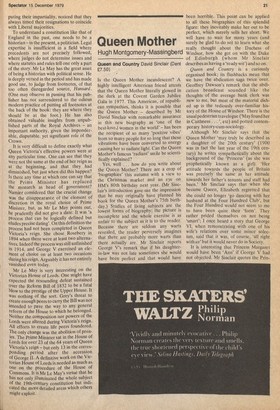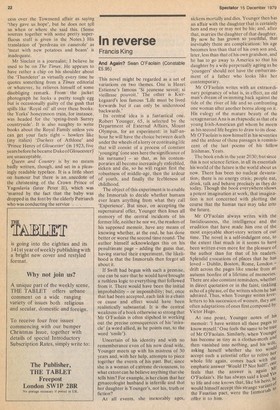Queen Mother
Hugh Montgomery-Massingberd
Queen and Country David Sinclair (Dent £7.50) Is the Queen Mother incandescent? A highly intelligent American friend attests that the Queen Mother literally glowed in the dark at the Covent Garden Jubilee Gala in 1977. This American, of republican sympathies, thinks it is possible that the Queen Mother — described by Mr David Sinclair with remarkable assurance in this new biography as `one of the best-loved women in the world' — has been the recipient of so many 'positive vibes' from so many people for so long that these vibrations have been converted to energy causing her to radiate light. Can the Queen Mother's famous 'radiant' smile be scientifically explained?
Yes, well . . • how do you write about the Queen Mother? There are a crop of 'biographies' this autumn with a view to the Christmas market and an eye on HM's 80th birthday next year. (Mr Sinclair's introduction gave me the impression that he may originally have planned his book for the Queen Mother's 75th birthday.) Studies of living subjects are the lowest forms of biography; the picture is incomplete and the whole exercise is as unfair to the subject as it is to the reader. Because there are seldom any warts revealed, the reader perversely imagines that there are probably more warts than there actually are. Mr Sinclair reports George V's remark that if his daughterin-law was not late sometimes she would have been perfect and that would have been horrible. This point can be applied to all these biographies of this splendid figure: they inevitably make her out to be perfect, which merely sells her short. We will have to wait for many years (and surely be glad to do so) to learn what she really thought about the Duchess of Windsor, how she got on with the Duke of Edinburgh (whom Mr Sinclair describes as having a 'ready wit') and so on.
Queen and Country is a curiously organised book; its flashbacks mean that we have the abdication saga twice over. Geoffrey Dawson's remark that the abdication broadcast sounded like the thoughts of the average bank clerk was new to me, but most of the material dished up is the tediously over-familiar history of the House of Windsor. There is the usual pedestrian travelogue Nay found her in Caithness. . . ', etc) and potted contemporary history-cum-sociology.
Although Mr Sinclair says that the Queen Mother 'may truly be described as a daughter of the 20th century' (1900 was in fact the last year of the 19th century) he writes sympathetically about the background of the `Princess' (as she was prophetically known as a girl). 'Her attitude towards the people of Britain was precisely the same as her attitude towards her father's tenants and staff had been.' Mr Sinclair says that when she became Queen, Elizabeth regretted that she could no longer 'go dancing with her husband at the Four Hundred Club', but the Four Hundred would not seem to me to have been quite their `form'. They rather prided themselves on not being 'smart': I once heard a story that George VI, when remonstrating with one of his wife's relations over some minor solecism, said that it was, of course, 'all right with us' but it would never do in Society.
It is interesting that Princess Margaret would have been 'Ann' if George V had not objected. Mr Sinclair quotes the Prin cess over the Townsend affair as saying 'they gave us hope', but he does not tell us when or where she said this. (Some sources together with some pretty superfluous stuff is given in the Notes.) His translation of 'perdreau en casserole' as 'meat with new potatoes and beans' is inadequate.
Mr Sinclair is a journalist; I believe he used to be on The Times. He appears to have rather a chip on his shoulder about the 'Thunderer' as virtually every time he quotes something from a Times editorial or whatever, he relieves himself of some disobliging remark. From the jacket photograph he looks a pretty tough egg but is occasionally guilty of the gush that spills like 'Royal oil' all over these books: the Yorks' honeymoon train, for instance, was headed for the 'spring-fresh Surrey countryside'. It is also naughty to write books about the Royal Family unless you can get your facts right — howlers like (my italics) 'Duchess of Athlone' and Prince Henry of Gloucester' (in 1923, five years before he became DukeofGloucesteri are unacceptable.
Queen and Country is by no means badly written, though, and set in a pleasingly readable typeface. It is a little short on humour but there is an anecdote of the christening of the Crown Prince of Yugoslavia (later Peter II), which was 'marred by the fact that the baby was dropped in the font by the elderly Patriarch who was conducting the service



































 Previous page
Previous page